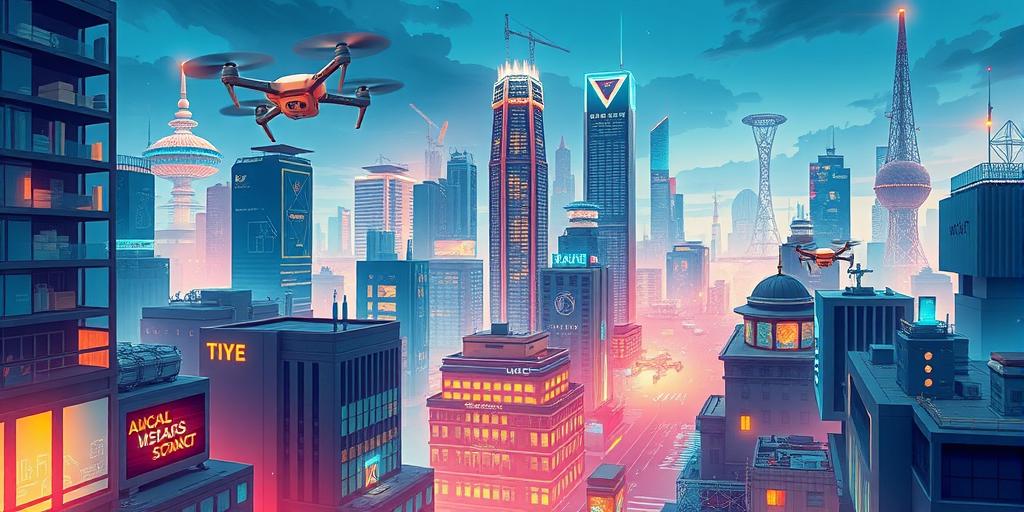The Internet of Things (IoT) is rapidly evolving, and its potential to revolutionize global infrastructure is immense. From smart cities to precision agriculture, IoT’s impact is already being felt, but its future applications hold even more transformative power. This comprehensive guide delves into the groundbreaking ways IoT is poised to tackle some of our world’s most pressing infrastructure challenges. Prepare to be amazed by the future of connectivity and its potential to reshape our world!
Smart Cities: IoT’s Urban Transformation
Imagine a city that anticipates your needs before you even realize them. This vision is quickly becoming a reality thanks to the power of IoT. By connecting various urban elements – traffic lights, power grids, waste management systems, and public transportation – cities can achieve unprecedented levels of efficiency and sustainability. IoT sensors collect real-time data on everything from traffic congestion to energy consumption. This data is then analyzed by advanced algorithms to optimize resource allocation and minimize waste. In essence, this data-driven approach empowers cities to transform into intelligent ecosystems where the systems and people that occupy the space work together. This includes the development of sophisticated traffic management systems that reduce congestion and improve air quality, intelligent lighting systems that only illuminate areas when needed, and smart waste management systems that optimize garbage collection routes and reduce landfill waste. Furthermore, IoT-enabled security systems enhances public safety by providing real-time monitoring and alerts in case of emergencies. The integration of these systems within a smart city framework provides a significant reduction in the overall resource costs, while improving the safety, welfare, and comfort of citizens.
IoT Applications in Urban Infrastructure
- Smart Parking: IoT sensors detect available parking spaces, guiding drivers to open spots and reducing traffic congestion.
- Predictive Maintenance: Sensors monitor the health of infrastructure, such as bridges and roads, enabling preventative maintenance and reducing the risk of failures.
- Smart Grids: IoT devices optimize energy distribution, improving efficiency and reducing energy waste.
Revolutionizing Agriculture with IoT-Based Precision Farming
The global food supply chain is under immense pressure. Feeding a growing population amidst increasing climate change challenges requires revolutionary innovations. Precision farming, powered by IoT, emerges as a critical solution. IoT sensors embedded in fields monitor soil conditions, weather patterns, and crop health. This real-time data empowers farmers to make informed decisions, optimizing irrigation, fertilization, and pest control. This precision approach results in increased crop yields, reduced resource waste, and ultimately, more sustainable agricultural practices. This is particularly significant given the global concerns surrounding food security and the impacts of climate change. By creating more resilient food production processes, IoT-based precision farming is integral to supporting a global population while minimizing environmental damage.
Precision Farming Technologies
- Smart Irrigation Systems: Sensors monitor soil moisture levels, ensuring efficient irrigation and reducing water waste.
- Drone-Based Monitoring: Drones equipped with sensors capture high-resolution images and data for precise crop analysis.
- Predictive Analytics: Advanced algorithms analyze data to predict crop yields and optimize farming practices.
Enhancing Disaster Response and Resilience with IoT
Natural disasters and unforeseen events can cripple infrastructure and leave devastating impacts. IoT technologies play an increasingly important role in improving disaster response and bolstering community resilience. IoT sensors deployed strategically can provide real-time alerts and data during emergencies, facilitating swift rescue efforts and minimizing losses. After disasters, IoT devices aid in assessing damage, coordinating recovery efforts, and restoring essential services. This quick response can often make the difference between life and death, and minimizes the economic and social disruption. Smart sensors and connected devices can be used to monitor environmental conditions, such as water levels in rivers or seismic activity, helping to predict and mitigate potential hazards. After an event, IoT technology greatly enhances response times and the effectiveness of emergency services.
Disaster Response Applications
- Early Warning Systems: IoT sensors detect early signs of natural disasters, alerting authorities and communities.
- Emergency Communication Networks: IoT networks provide reliable communication during emergencies, even when traditional networks are down.
- Damage Assessment: IoT-enabled drones and sensors can quickly assess damage to infrastructure after disasters.
The Future of IoT in Infrastructure: Challenges and Opportunities
The widespread adoption of IoT in infrastructure faces challenges such as data security and privacy, interoperability of devices and systems, and the need for robust infrastructure to support the massive amounts of data generated. Addressing these concerns is crucial for realizing the full potential of IoT. The convergence of IoT, artificial intelligence (AI), and machine learning (ML) will create even more advanced capabilities to manage and optimize infrastructure systems. The combination of these technologies can create new opportunities for economic growth, improve our ability to respond to global challenges, and foster a more sustainable future for humanity.
Embrace the future – be a part of this exciting technological advancement. Take advantage of the wealth of resources and opportunities to learn more, and help shape the evolution of this groundbreaking technology.




